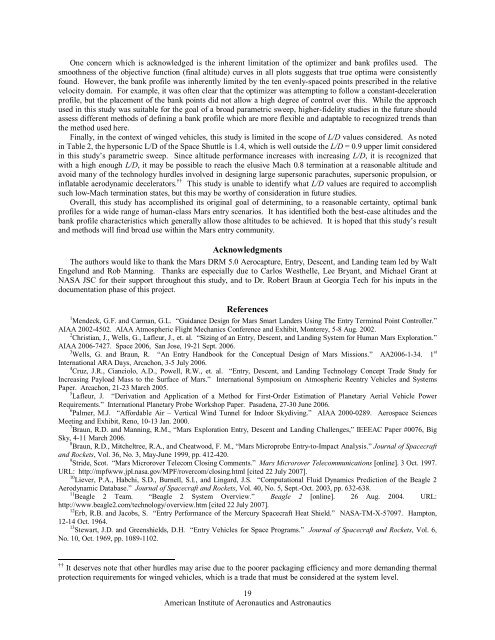Mars Entry Bank Profile Design for Terminal State Optimization
Mars Entry Bank Profile Design for Terminal State Optimization
Mars Entry Bank Profile Design for Terminal State Optimization
You also want an ePaper? Increase the reach of your titles
YUMPU automatically turns print PDFs into web optimized ePapers that Google loves.
One concern which is acknowledged is the inherent limitation of the optimizer and bank profiles used. The<br />
smoothness of the objective function (final altitude) curves in all plots suggests that true optima were consistently<br />
found. However, the bank profile was inherently limited by the ten evenly-spaced points prescribed in the relative<br />
velocity domain. For example, it was often clear that the optimizer was attempting to follow a constant-deceleration<br />
profile, but the placement of the bank points did not allow a high degree of control over this. While the approach<br />
used in this study was suitable <strong>for</strong> the goal of a broad parametric sweep, higher-fidelity studies in the future should<br />
assess different methods of defining a bank profile which are more flexible and adaptable to recognized trends than<br />
the method used here.<br />
Finally, in the context of winged vehicles, this study is limited in the scope of L/D values considered. As noted<br />
in Table 2, the hypersonic L/D of the Space Shuttle is 1.4, which is well outside the L/D = 0.9 upper limit considered<br />
in this study’s parametric sweep. Since altitude per<strong>for</strong>mance increases with increasing L/D, it is recognized that<br />
with a high enough L/D, it may be possible to reach the elusive Mach 0.8 termination at a reasonable altitude and<br />
avoid many of the technology hurdles involved in designing large supersonic parachutes, supersonic propulsion, or<br />
inflatable aerodynamic decelerators. †† This study is unable to identify what L/D values are required to accomplish<br />
such low-Mach termination states, but this may be worthy of consideration in future studies.<br />
Overall, this study has accomplished its original goal of determining, to a reasonable certainty, optimal bank<br />
profiles <strong>for</strong> a wide range of human-class <strong>Mars</strong> entry scenarios. It has identified both the best-case altitudes and the<br />
bank profile characteristics which generally allow those altitudes to be achieved. It is hoped that this study’s result<br />
and methods will find broad use within the <strong>Mars</strong> entry community.<br />
Acknowledgments<br />
The authors would like to thank the <strong>Mars</strong> DRM 5.0 Aerocapture, <strong>Entry</strong>, Descent, and Landing team led by Walt<br />
Engelund and Rob Manning. Thanks are especially due to Carlos Westhelle, Lee Bryant, and Michael Grant at<br />
NASA JSC <strong>for</strong> their support throughout this study, and to Dr. Robert Braun at Georgia Tech <strong>for</strong> his inputs in the<br />
documentation phase of this project.<br />
References<br />
1 Mendeck, G.F. and Carman, G.L. “Guidance <strong>Design</strong> <strong>for</strong> <strong>Mars</strong> Smart Landers Using The <strong>Entry</strong> <strong>Terminal</strong> Point Controller.”<br />
AIAA 2002-4502. AIAA Atmospheric Flight Mechanics Conference and Exhibit, Monterey, 5-8 Aug. 2002.<br />
2 Christian, J., Wells, G., Lafleur, J., et. al. “Sizing of an <strong>Entry</strong>, Descent, and Landing System <strong>for</strong> Human <strong>Mars</strong> Exploration.”<br />
AIAA 2006-7427. Space 2006, San Jose, 19-21 Sept. 2006.<br />
3 Wells, G. and Braun, R. “An <strong>Entry</strong> Handbook <strong>for</strong> the Conceptual <strong>Design</strong> of <strong>Mars</strong> Missions.” AA2006-1-34. 1 st<br />
International ARA Days, Arcachon, 3-5 July 2006.<br />
4 Cruz, J.R., Cianciolo, A.D., Powell, R.W., et. al. “<strong>Entry</strong>, Descent, and Landing Technology Concept Trade Study <strong>for</strong><br />
Increasing Payload Mass to the Surface of <strong>Mars</strong>.” International Symposium on Atmospheric Reentry Vehicles and Systems<br />
Paper. Arcachon, 21-23 March 2005.<br />
5 Lafleur, J. “Derivation and Application of a Method <strong>for</strong> First-Order Estimation of Planetary Aerial Vehicle Power<br />
Requirements.” International Planetary Probe Workshop Paper. Pasadena, 27-30 June 2006.<br />
6 Palmer, M.J. “Af<strong>for</strong>dable Air – Vertical Wind Tunnel <strong>for</strong> Indoor Skydiving.” AIAA 2000-0289. Aerospace Sciences<br />
Meeting and Exhibit, Reno, 10-13 Jan. 2000.<br />
7 Braun, R.D. and Manning, R.M., “<strong>Mars</strong> Exploration <strong>Entry</strong>, Descent and Landing Challenges,” IEEEAC Paper #0076, Big<br />
Sky, 4-11 March 2006.<br />
8 Braun, R.D., Mitcheltree, R.A., and Cheatwood, F. M., “<strong>Mars</strong> Microprobe <strong>Entry</strong>-to-Impact Analysis.” Journal of Spacecraft<br />
and Rockets, Vol. 36, No. 3, May-June 1999, pp. 412-420.<br />
9 Stride, Scot. “<strong>Mars</strong> Microrover Telecom Closing Comments.” <strong>Mars</strong> Microrover Telecommunications [online]. 3 Oct. 1997.<br />
URL: http://mpfwww.jpl.nasa.gov/MPF/rovercom/closing.html [cited 22 July 2007].<br />
10 Liever, P.A., Habchi, S.D., Burnell, S.I., and Lingard, J.S. “Computational Fluid Dynamics Prediction of the Beagle 2<br />
Aerodynamic Database.” Journal of Spacecraft and Rockets, Vol. 40, No. 5, Sept.-Oct. 2003, pp. 632-638.<br />
11 Beagle 2 Team. “Beagle 2 System Overview.” Beagle 2 [online]. 26 Aug. 2004. URL:<br />
http://www.beagle2.com/technology/overview.htm [cited 22 July 2007].<br />
12 Erb, R.B. and Jacobs, S. “<strong>Entry</strong> Per<strong>for</strong>mance of the Mercury Spacecraft Heat Shield.” NASA-TM-X-57097. Hampton,<br />
12-14 Oct. 1964.<br />
13 Stewart, J.D. and Greenshields, D.H. “<strong>Entry</strong> Vehicles <strong>for</strong> Space Programs.” Journal of Spacecraft and Rockets, Vol. 6,<br />
No. 10, Oct. 1969, pp. 1089-1102.<br />
†† It deserves note that other hurdles may arise due to the poorer packaging efficiency and more demanding thermal<br />
protection requirements <strong>for</strong> winged vehicles, which is a trade that must be considered at the system level.<br />
19<br />
American Institute of Aeronautics and Astronautics
















